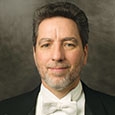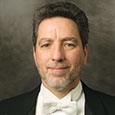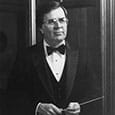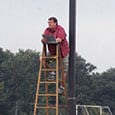Bands and orchestras spend much more time in rehearsal than in performance, and waiting until right before a concert to focus on musicality will not produce good results. Many years ago, a veteran high school director who had a strong program asked me to work with his ensemble the week before a music festival. He said, “We have everything together now, and we just need you to add the music on top.” His request was sincere and serious, but I looked at him confused and asked what he meant. He replied, “We have done all our practice sessions and have everything correct, and what we need now is to add the music on top.” His ensemble did indeed have the technical aspects of the music down, but it was almost impossible to make music with them. We talked repeatedly about pulling back at the end of a phrase or changing a dynamic marking to be more reflective of what was happening, but the students were so locked in how they had learned the music that they were unable to make changes. They were too focused on making sure they made no mistakes. In the end, there was no way to add the music on top, because they had not been making music for the last two months they had been preparing.
Rather than view daily rehearsals as a practice and review session, use each meeting as an opportunity to make music. Even in the early stages of learning a new piece, directors should insist on musical playing. One of my favorite sayings is that the first rehearsal is the conductor’s performance. Whether it is with a middle school, high school, college, or community group, and regardless of whether a piece is short and simple or long and complicated, conductors should approach everything as if it was a performance.
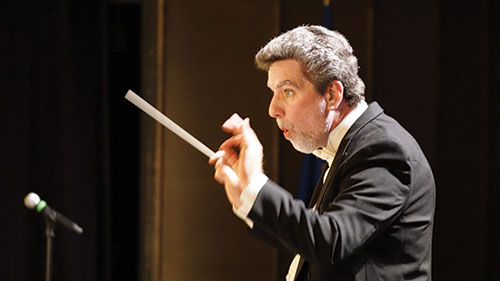
A Conductor’s Job
When someone graduates from college, they are on their own, and the onus of improving as a conductor is entirely on them. A mentor once asked me: When do you take responsibility for what you do not know? The simple answer is as soon as you know you don’t know something. When a director says he is not a good conductor because he did not have a good conducting class in college, this communicates an awareness of a weakness and a belief that it is important. Rather than do something about it, it is used as an excuse.
Musicians would never think about playing a solo on their primary instrument in public without practicing and preparing, but many see no problem standing in front of a group having never prepared a score or practiced gestures. Too many conductors can get away with that, especially with younger groups, by blaming the ensemble.
While it is easy to blame students for poor music making, it is often our shortcomings that contribute to this problem. Conducting basic beat patterns and trying to stay out the way will not lead to musical playing. In addition to developing more effective technique, we must also believe our students can watch and react appropriately to our conducting gestures. It is our responsibility to teach them how to do this.
Practice with Recordings
A conductor’s instrument is the ensemble, not the baton or a hand. In a conducting class, you have an ensemble to practice with, but this is not true anywhere else, so I encourage my students to conduct with recordings. There are pros and cons to this. One of the biggest negatives is that you will not affect the sound of the recorded ensemble at all. This is unfortunate, because hearing an ensemble react to gestures is how we learn what works. On the other hand, a recorded ensemble is not going to stop for your mistakes, which forces you to adapt and keep going. Conducting to a recording is also a chance to separate types of gestures. Run through a piece and work only on dynamic or style gestures. Another good type of practice is to drop the right hand and conduct only the gestures you would use in the left.
Although conducting recordings is a valuable tool, I do not do so anymore, and all conductors should reach that point. Eventually, studying the score leads to an interpretation, which dictates what kind of gestures to use. Stay open to the possibility that a gesture will not receive the desired response from the ensemble. On the podium, the conductor is the composer’s advocate. Unless you only program one style of music, you need to be able to display multiple personalities in front of your group to make each piece come alive. That leads to the question of what you are willing to do to get the sound you want. If you are willing to do anything, the possibilities are endless.
Practice During Rehearsals
It is essential for a conductor to have the desired sound in mind before stepping on the podium; the aim is to translate that aural image to gestures. If you stand in front of a group with little idea about where the music should go or what you want to bring out, it is impossible to conduct musically. The desired sound may change or mature as you work on the music, but if we do not shape the sound from the beginning, it will not magically happen at the end.
In choral music, everyone sees all the vocal parts and the piano accompaniment. This is an advantage over an instrumental ensemble, where musicians only see their part. Players in sections with multiple parts don’t even get to see what everyone in their section is doing; only the conductor has the full score. In rehearsal, we take students on a tour of the piece, pointing out the important spots and showing everyone how their part fits into the whole.
Take advantage of the view you have by being prepared to conduct each part in every section of the music. Every time you rehearse a section of the ensemble is a chance to work on gestures. If a passage breaks down into four components, such as melody, countermelody, harmonic accompaniment, and bassline, be able to conduct each part as if it was the only one that existed. When rehearsing just one part, conduct every nuance from that part that can be shown with gestures. For example, if you need to work with the clarinet section, your conducting gestures should show every nuance of the clarinet parts. If you do not get the response you want, try a different gesture. Only then, if the desired response still is not there, is it time to stop and talk about it.
When putting all the parts together, you will have to make choices about what to show. This means jumping back and forth between parts. Resist the urge to conduct only the melody; it is the other parts that make or break the music. We all want to conduct that beautiful melodic line, but chances are you picked a piece with a beautiful oboe solo because you have a good oboist. It may be that you need to guide that melodic solo a bit, but it is probably all the other parts that need more help. A composer would not have written an unimportant part, so a conductor’s job is to make sure it is heard, whether prominently or as part of the texture. You are prepared when you can jump quickly to any part at any time to assist those players or bring that part out. This is impossible to do without score study and practice. The end result of studying your conducting should be a vocabulary of gestures that shapes the music the ensemble is making.
This is especially important for transitions. A transition can be as small as a dynamic change or as big as a whole new style, tempo, and key, but all are important. Good ensembles play all the main melodic parts well, however great ensembles pay attention to the transitions. If we do not show such things in our conducting, then we cannot expect students to do it for us. We are there to lead students through the process of making music.
Warmups Are for Watching
I have had conductors tell me that their students never look up from the music, but students only look up if you give them something to look at. One pet peeve of mine is when I see directors warming up their group with no engagement, playing scales or chorales on autopilot. These standard warmup exercises can be effective for teaching students how to make music, as well as wonderful opportunities to practice conducting.
One of my favorite warmups is to play a scale up and down, with four quarter notes per scale degree. I do something different on every beat, so students know they are going to have to watch. After that I move to chorales or etudes. The first time, I conduct straight through with little or no musicality but then immediately say, “Let’s try again and see what kind of music we can make together.” At this point I will try outlandish things to get them to follow. This helps students get used to my gestures and proves to them that they are capable of quickly adjusting to what they see from the conductor.
Warmups are also an outstanding opportunity to teach conducting gestures to our ensemble. We wonder why students do not play with more musicality and conclude that they are not old enough or not prepared enough, but students learn how to play musically by watching the conductor. With young groups we will have to show them a gesture and put a sound with it, but it is possible. Insist that warmups (and everything else) be played musically. When the ensemble does not play what you ask for through gestures, work together until students understand what you want.
What to Do with Video
Video is one of the most effective tools for assessing conducting. Many people are self-conscious about how they look when conducting, but the only way to overcome this is to record multiple rehearsals and performances. Also, watch the same recording multiple times, as you will miss things if you watch only once.
Make an honest assessment of what you notice, as this is an opportunity to really explore what you are doing as a conductor. I see many conductors whose gestures, while clear, are all one size and style. Everything looks the same. To avoid this, I suggest occasionally watching the tape with the sound off. Look away from the video for a short period of time, and then turn back. If you struggle to determine where you are in the music based on your gestures (which should clearly indicate style, dynamics, and tempo), then there is a disconnect with what you are showing in your conducting and how the music should sound.
The head should not be buried in the score. It is impossible to get students to react to you unless you engage them with good eye contact and facial expressions; show the emotion you want on your face and in your body language. When I chat with my conducting students in the hallway, they are animated, but then the minute they step on the podium, they become blank. This is often because they are concentrating, but the aim is for conductors to be themselves and be natural. Music is transposed emotion, and it is imperative that we reflect this emotion in the face.
Mirror conducting is effective and important in some places, but too much of it teaches the ensemble they don’t need to look at your left hand. As much as possible, avoid mirror conducting and save the left hand for other things.
An extra benefit of recording yourself conducting is the opportunity to assess your rehearsal techniques as well. Ask yourself the difficult questions: How much of your rehearsal time is spent with you talking versus students playing? Do the students seem interested and on-task? How is the pacing of your rehearsal? Did you accomplish the goals you had set for this rehearsal?
Conclusion
We teach music through performance. That performance is not just on the concert hall stage or at a festival, it is also in our rehearsal rooms. Conducting is an art form. If we treat it as functional and mechanical, then that is what our gestures will show and how our ensembles will sound. Conducting musically has a wonderful effect on the music your ensemble makes and has to be our top priority. If you are neutral as a conductor, you are hurting your ensemble. You are either part of the music-making process or negating the possibility of making music. To teach your students music through performance, become the strongest conductor you can possibly be. Great teaching includes great conducting. It makes a difference.
Five Tips for Improving Conducting
• Ask a colleague or mentor to watch your video or observe you in rehearsal.
• Attend a conducting workshop. These professional development opportunities are increasingly common. Available at various times throughout the academic year and summer, they can last anywhere from two days to two weeks.
• Observe other conductors at their rehearsals and performances. Make note of what seems to be effective as well as areas that concern you. Analyze how these conductors approach their craft.
• Take conducting lessons.
• Read a book to expand your knowledge and thought process. There are now many resources available that specifically deal with the art of conducting. Three recent publications I would highly recommend: Frank Battisti’s excellent On Becoming a Conductor; Score and Rehearsal Preparation by Gary Stith; and The Conductor as Leader by Ramona Wis. These particular books, while less about conducting technique, do explore how we approach what we do, as well as how we do it.
